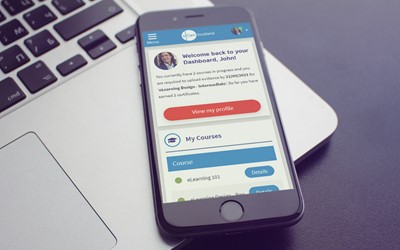The Loneliness of the Lone Worker - How to Provide Appropriate Training and Development for your Lone Workers
My team here at eCom reminded me today that, over the last year, I had been talking with them at length about how to support our lone workers and how they are often forgotten in companies, especially training for lone workers and their development. This article from our CEO, Linda Steedman, will give you an idea of how eCom does this, as well as offering some practical steps you can apply in your organisation.
Posted 16 April 2020
A culture of inclusivity
We have a few lone workers, spread geographically and across time zones. We have their pictures on the wall and clocks that show the time where they are. They are part of our virtual management systems, we include them in the daily stand-up (meetings) they are on our Learning Academy and they have their own development plan. It took a real concerted effort from our senior team to get this working well. This is because, like all busy companies, everybody is wrapped up in their own role and tend to see only what or who’s directly in their immediate sight.
Who would have thought that now, because of the pandemic, our whole team would effectively be lone workers, all working from home. We transitioned very smoothly due to having systems and plans in place, but how do you manage?
Preparing for this change
Organisations likely to have a significant role to play as essential services in the next 3-6 months are often the ones least prepared to manage this change and operate with many lone workers. What follows is how eCom managed the change, as well as some practical steps you can apply in your organisation.
1) We had to change the way our employees reported for work and how they got their work activities
We are lucky as all our systems are cloud services, so for many it was business as usual. We did expand our use of Microsoft Teams to do a check-in each morning and we also use ClickUp and Basecamp to manage our work activities. Our eCom Academy (eNetEnterprise) is used to provide training for loan workers, courses, personal reviews, coaching and access to important documentation.
2) You might be wondering what is possible for you to put in place?
If it is only for a couple of months, there are simple things you can do. Many key workers in factories, transport and healthcare essential services are going to feel isolated due to the restrictions. Identify supervisors or setup buddies who can connect with a small group of employees, either by phone, online chat or email.
Provide your employees with a system like a cloud-based LMS that can act as a central point and can be setup very quickly. Send out messages with activities they need to focus on for the next week. You can also use a shared document service if you don’t have one.
3) The resources we needed had to change, since line managers and supervisors are now also home workers
Many of you will be the same, with line managers at home and essential employees on the front line. We had to ensure our key workers were safe and combat any poor practices for lone workers at this time. We really focussed on how we communicate with our teams, to ensure employees have a clear understanding of their responsible duties, with the awareness that these might change due to the pandemic circumstances they are working in. We found there is a lot of fear out there and this clarity was needed to alleviate their concerns. We checked all the digital resources we had to circulate, making sure we covered what employees must know about working safely and preventing any contamination at this time. We provided COVID-19 courses on the eCom Academy for employees to learn about this at their own pace.
4) We encouraged our loan workers to carry out training
I heard a lot of employees saying they didn’t have time for training. We found loads of bite-sized learning available and our Academy is an easy way of tracking this has been done. We set up 15 minutes learning time in each employee’s working day as virtual break for those at home, or an actual break for those in work and found that productivity actually improved. You might find offering a small amount of training time each day improves productivity in your organisation, as employees feel more engaged in the business.
5) We kept things simple to start with
We didn’t try to anticipate everything. I can assure you that once everyone started working remotely, it did add some more complexity as we replicated our organisations culture on the activities our teams undertook.
6) We really supported our supervisors, line managers, team leads
These people are key to our success. We spoke daily with our immediate group to see what support they needed and ask then to cascade this down the organisation. Often it was the simple things that meant the most.
You could try out ways of supporting your own team before you roll this out to your wider group. Be empathetic as working alone is hard for some people.
7) We found there is a lot of fear around with news stories about people losing their jobs
Many were worried about working on their own in case they didn’t do a good job. Keeping good communication going is essential to keep that employee engaged and feel the work they are doing is making a difference. We provided a poll at the start of the week to see how everyone was feeling, with a weekly briefing on a Friday about the work being done and how well everyone was coping. It was important that everyone felt the company is supporting them and trusted the information they were receiving. Like you our L&D and HR teams were at the front line of this activity, with business success in the long term being predicated on the support activities we do now. Much of the training for loan workers was focussed on “what we can do now” and “what we can’t”, and on how to get help and clear advice when situations present themselves. Like us, your employees need to feel safe and secure in all aspects of their job.
8) We carried out a number of risk assessments
We provided coaching, mentoring, upskilling on remote supervision and monitoring so our team leads understood what is expected of them. Systems of reporting had to be reworked to meet the challenges of home working and this needed to be put in place at the correct level for each job role. We were able to use our eCom Academy to do this, but shared documentation solutions will also work.
9) We had to review all our policies and procedures
Some needed small tweaks around IT security for home working, these were changed and circulated. Questions, surveys and polls were setup digitally so we can assess how things are going as well as check understanding and compliance. You might need to consider any health and hygiene policies and work instructions for those in work.
10) We double checked our data security
We needed to mitigate any risks from insecure devices, since, many home computers don’t have the level of protection outlined in your company IT policies. So we trained loan workers on how to spot cyber-attacks and phishing emails, since these are on the rise, with criminals taking advantage of the speed at which companies had to move online.
Dealing with Digital Disruption
Before this pandemic, only 13% of companies indicated they were ready to deal with digital disruption. Working alone, or at home, is going to be the new norm for many for some time, however, many employees have never done this before. With all senior teams facing the general difficulties of trying to keep going and providing a business as usual offering, I hope our story of how we implemented these 10 points will help you identify some of the key points you need to consider.


